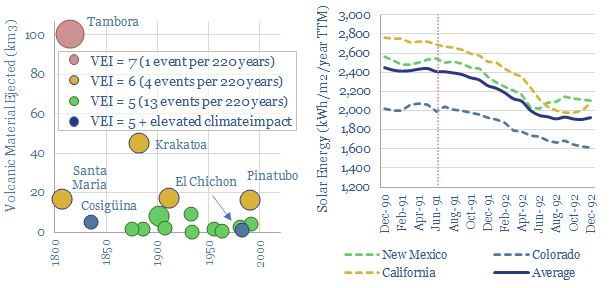This data-file aggregates data on c20 of the largest volcanic eruptions of the past 200-years, with a VEI of 5 or above, to quantify volcano impacts on solar power. Specifically, VEI denotes the ‘Volcanic Explosivity Index‘, a logarithmic scale that has become the standard for measuring volcanic eruptions.
For example, the 2010 eruption of Iceland’s Eyjafjallajökull volcano, which disrupted global air travel, was assessed at VEI=4, emitting 0.3km3 of tephra, 8km into the atmosphere. The VEI=5 eruptions in this data-file emitted an average of 3km3 of debris up to 20km into the atmosphere. Three VEI=6 eruptions (Pinatubo, Krakatoa, Novarupta) released 15-45km3 up to 40-80km upwards. Finally, the largest volcanic eruption since 1800 was Mount Tambora, resulting in the ‘year without a summer’ in 1816, ejecting 100km3 of material.
The data suggest that very large volcanic events occur every 30-years, on average, pushing aerosols into the upper atmosphere, dimming the sun, and thus cooling the climate by 0.5-1.2 C for 1-3 years.
Solar energy implications? So what happens as we build out solar generation in our energy mix? One technical paper has quantified how incoming solar energy measured by weather stations in the US (California, Colorado, New Mexico) fell by 20% in 1992, the year after the eruption of Mount Pinatubo, 12,000 km away, in the Philippines in 1991 (monthly data are also tabulated in this data-file).
This suggests a large systemic risk. Our roadmap to net zero sees 10% of all global energy coming from solar by 2050 (around 10,000 TWH per year). Once every thirty years, we might expect a large volcanic eruption to lower global solar insolation by c20%, thereby detracting 2,000 TWH pa from the world’s future energy system. This is the energy equivalent of Saudi Arabia’s oil simply disappearing from the market for 1-2 years. (data here)
Evaluating volcano impacts on solar power is not intended as an argument against solar. We need more solar in a decarbonizing energy system (research here). However, we think a resilient energy system likely needs to be diversified, with a large buffer of spare capacity, spanning across secure and non-correlated input sources.

